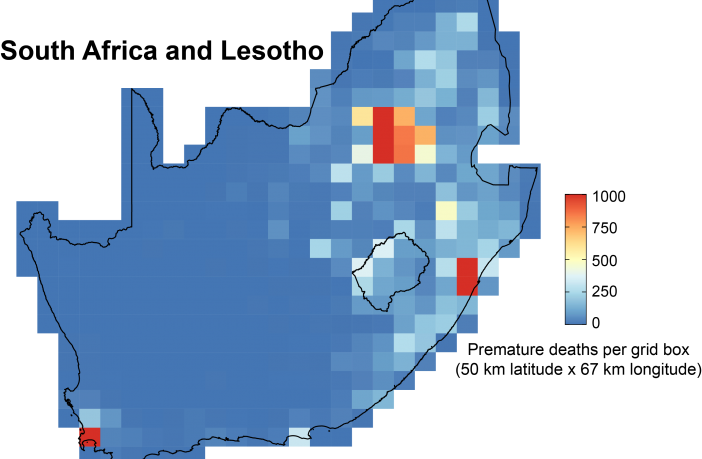Study
- Fossil fuel air pollution responsible for 1 in 5 deaths worldwide – major study
- Deaths from fossil fuel emissions higher than previously thought.
More than 8 million people died in 2018 from fossil fuel pollution, significantly higher than previous research suggested, meaning that air pollution from burning fossil fuels like coal and diesel was responsible for about 1 in 5 deaths worldwide, according to new research from Harvard University, in collaboration with the University of Birmingham, the University of Leicester and University College London.
Regions with the highest concentrations of fossil fuel-related air pollution — including Eastern North America, Europe, and South-East Asia — have the highest rates of mortality, according to the study published in the journal Environmental Research.
The study greatly increases estimates of the numbers killed by air pollution. The most recent Global Burden of Disease Study, the largest and most comprehensive study on the causes of global mortality, put the total number of global deaths from all outdoor airborne particulate matter — including dust and smoke from wildfires and agricultural burns — at 4.2 million.
How did the researchers arrive at such a high number of deaths – 8.7 million in 2018 – for fossil fuels alone?
Previous research relied on satellite and surface observations to estimate the average global annual concentrations of airborne particulate matter, known as PM2.5. The problem is, satellite and surface observations can’t tell the difference between particles from fossil fuel emissions and those from dust, wildfire smoke or other sources.
“With satellite data, you’re seeing only pieces of the puzzle,” said Loretta J. Mickley, Senior Research Fellow in Chemistry-Climate Interactions at the Harvard John A. Paulson School of Engineering and Applied Sciences (SEAS) and co-author of the study. “It is challenging for satellites to distinguish between types of particles, and there can be gaps in the data.”
To overcome this challenge, the Harvard researchers turned to GEOS-Chem, a global 3-D model of atmospheric chemistry led at SEAS by Daniel Jacob, the Vasco McCoy Family Professor of Atmospheric Chemistry and Environmental Engineering. Previous studies have used GEOS-Chem to model the health impacts of particulate matter, and its results have been validated against surface, aircraft, and space-based observations around the world.
For a global model, GEOS-Chem has high spatial resolution, meaning the researchers could divide the globe into a grid with boxes as small as 50 km x 60 km and look at pollution levels in each box individually.
“Rather than rely on averages spread across large regions, we wanted to map where the pollution is and where people live, so we could know more exactly what people are breathing,” said Karn Vohra, a graduate student at University of Birmingham and first author of the study. Vohra is advised by coauthor Eloise Marais, a former postdoctoral fellow at Harvard, now Associate Professor in the Department of Geography at UCL.
To model PM2.5 generated by fossil fuel combustion, the researchers plugged into GEOS-Chem estimates of emissions from multiple sectors, including power, industry, ships, aircraft and ground transportation and simulated detailed oxidant-aerosol chemistry driven by meteorology from the NASA Global Modeling and Assimilation Office.
Once they had the concentration of outdoor fossil-fuel PM2.5 for each grid box, the researchers needed to figure out how those levels impacted human health. While it’s been known for decades that airborne particles are a danger to public health, there have been few epidemiological studies to quantify the health impacts at very high levels of exposure such as those found in China or India. Previous research converted health risks of indoor second-hand smoke exposures to estimate the risks of outdoor PM2.5 at these high levels. However, recent studies from Asia found that this approach substantially underestimates the risk at high concentrations of outdoor air pollution.
Coauthors Alina Vodonos and Joel Schwartz, Professor of Environmental Epidemiology at the Harvard T.H. Chan School of Public Health (HSPH), developed a new risk assessment model that linked the concentration levels of particulates from fossil fuel emissions to health outcomes.
This new model found a higher mortality rate for long-term exposure to fossil fuel emissions, including at lower concentrations. The researchers found that globally, exposure to particulate matter from fossil fuel emissions accounted for 21.5 percent of total deaths in 2012, falling to 18% in 2018 due to tightening air quality measures in China.
“Often, when we discuss the dangers of fossil fuel combustion, it’s in the context of CO2 and climate change and overlook the potential health impact of the pollutants co-emitted with greenhouse gases,” said Schwartz. “We hope that by quantifying the health consequences of fossil fuel combustion, we can send a clear message to policymakers and stakeholders of the benefits of a transition to alternative energy sources.”
“Our study adds to the mounting evidence that air pollution from ongoing dependence on fossil fuels is detrimental to global health,” said Marais. “We can’t in good conscience continue to rely on fossil fuels, when we know that there are such severe effects on health and viable, cleaner alternatives.”
Notes
The study authors are:
- Karn Vohra, School of Geography, Earth and Environmental Sciences, University of Birmingham, Birmingham, UK
- Alina Vodonos, Harvard T.H. Chan School of Public Health, Department of Environmental Health, Harvard University, Boston, MA, USA
- Joel Schwartz, Harvard T.H. Chan School of Public Health, Department of Environmental Health, Harvard University, Boston, MA, USA
- Eloise A. Marais, Department of Geography, University College London, London, UK
- Melissa P. Sulprizio, John A. Paulson School of Engineering and Applied Sciences, Harvard University, Cambridge, MA, USA
- Loretta J. Mickley, John A. Paulson School of Engineering and Applied Sciences, Harvard University, Cambridge, MA, USA
It was supported by the Wallace Global Fund, the Environment and Health Fund (EHF) Israel, and University of Birmingham Global Challenges PhD studentship.
Author: GBA News Desk















